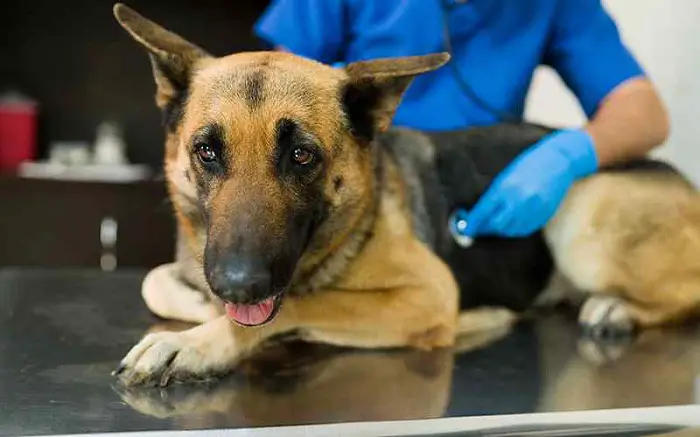Hemangiosarcoma is a highly malignant and aggressive form of cancer that mainly affects the blood vessels in dogs. Hemangiosarcoma in dogs arises from the cells that line blood vessels, known as endothelial cells. This cancer can occur in various organs and tissues in the body, but it most commonly develops in dogs’ spleen, heart, and liver.
Causes of Hemangiosarcoma in Dogs
The exact causes of hemangiosarcoma are not entirely determined, but several factors may contribute to its development:
- Genetics: There is evidence to suggest that genetics plays a role in the development of hemangiosarcoma. Some dog breeds, such as German Shepherds, Golden Retrievers, and Labrador Retrievers, are more predisposed to this cancer. This suggests that certain genetic factors may increase a dog’s susceptibility to the disease.
- Age and Gender: Hemangiosarcoma is most commonly diagnosed in middle-aged to older dogs, typically between 6 and 13. It also appears to affect males more frequently than females.
- Environmental Factors: While no specific environmental factors have been definitively linked to hemangiosarcoma, exposure to particular carcinogens or toxins could play a role in its development. However, this remains an area of ongoing research.
- Immune System Dysfunction: Some researchers believe a weakened or compromised immune system may contribute to developing hemangiosarcoma. Immune system dysfunction could potentially allow cancer cells to proliferate more easily.
- Hormonal Factors: Hormonal influences, such as fluctuations in sex hormones, have been suggested as a possible contributing factor in hemangiosarcoma development. However, more research is needed to understand this relationship fully.
- Inflammatory Conditions: Chronic inflammation may increase the risk of developing cancer, including hemangiosarcoma. Inflammation can lead to genetic mutations and cell damage, potentially increasing the likelihood of cancer.
Clinical Signs of Hemangiosarcoma in Dogs
Hemangiosarcoma in dogs can be challenging to detect early because it often doesn’t produce specific symptoms until the disease is quite advanced. The clinical signs of hemangiosarcoma can vary depending on the affected organ and whether the cancer has metastasized to other parts of the body. Common clinical signs of hemangiosarcoma in dogs include:
- Lethargy: A general lack of energy is a common early sign of many diseases, including hemangiosarcoma.
- Weakness: Dogs with hemangiosarcoma may become progressively weaker and less active.
- Loss of Appetite: Dogs with this cancer may lose interest in eating, resulting in weight loss.
- Pale Gums: Hemangiosarcoma can cause internal bleeding, leading to pale or white gums.
- Abdominal Distension: If the cancer is in the spleen, it can cause the abdomen to become distended or swollen due to blood accumulating in the abdomen.
- Difficulty Breathing: When hemangiosarcoma affects the heart, it can accumulate fluid in the chest, causing difficulty breathing.
- Collapse: In some cases, dogs with hemangiosarcoma may suddenly collapse due to internal bleeding or the rupture of a tumor.
- Irregular Heartbeat: Hemangiosarcoma in the heart can disrupt the heart’s normal rhythm, leading to an irregular heartbeat.
- Seizures: If the cancer affects the brain, it can cause seizures.
- Lameness or Swelling: If the cancer is located in the limbs or under the skin, lameness or noticeable swelling may occur.
- Coughing or Respiratory Distress: Hemangiosarcoma that affects the lungs can lead to coughing, labored breathing, or respiratory distress.
Diagnosis of Canine Hemangiosarcoma
Diagnosing canine hemangiosarcoma typically involves a combination of clinical evaluation, imaging studies, and often histopathology (examination of tissue samples). Here is an overview of the diagnostic process for canine hemangiosarcoma:
- Clinical Evaluation: The first step in diagnosing hemangiosarcoma is a veterinarian’s thorough physical examination of the dog. The vet will discuss the dog’s medical history and ask about any symptoms or changes in behavior that the owner has observed.
- Bloodwork: Blood tests, including a complete blood count (CBC) and serum biochemistry panel, are usually performed to assess the dog’s overall health and detect any abnormalities associated with hemangiosarcoma, such as anemia or changes in liver or kidney function.
- Imaging Studies:
- X-rays: Radiographs (X-rays) can help identify abnormalities in the chest or abdomen, such as tumors, fluid accumulation, or enlarged organs.
- Ultrasound: Ultrasonography is a valuable tool for evaluating abdominal organs like the spleen, liver, and heart. It can reveal the presence of tumors, bleeding, or other abnormalities.
- Echocardiography: If hemangiosarcoma is suspected in the heart, an echocardiogram (heart ultrasound) may assess cardiac function and identify any masses or structural abnormalities.
- Fine Needle Aspiration (FNA): In cases where a mass or tumor is identified on imaging, a fine needle aspiration may be performed. A small sample of cells is aspirated from the tumor and examined under a microscope to determine if they appear consistent with hemangiosarcoma. While FNA can provide valuable information, it may only sometimes yield a definitive diagnosis.
- Biopsy: A definitive diagnosis of hemangiosarcoma often requires a biopsy. This involves surgically removing a tissue sample from the suspected tumor or affected organ. The tissue is then sent to a pathologist for histopathological examination. Hemangiosarcoma cells have distinct characteristics that can be identified under a microscope, allowing for a definitive diagnosis.
- Exploratory Surgery: In cases where hemangiosarcoma is suspected but not definitively diagnosed with less invasive methods, exploratory surgery may be necessary. The veterinarian can visually inspect the organs and take biopsies for confirmation during surgery.
Differential Diagnosis of Hemangiosarcoma in Dogs
When a dog presents with clinical signs suggestive of hemangiosarcoma, veterinarians need to consider a range of differential diagnoses, as many of the symptoms associated with hemangiosarcoma are non-specific and can be caused by other medical conditions. Differential diagnoses for hemangiosarcoma in dogs may include:
- Splenic Masses: Not all splenic masses are hemangiosarcomas. Other benign or malignant tumors, such as hemangiomas, nodular hyperplasia, and hematomas, can also affect the spleen. Differential diagnosis often involves imaging, fine needle aspiration, or biopsy.
- Hemorrhagic Gastrointestinal Conditions: Conditions like gastric or intestinal ulcers, gastrointestinal tumors, or inflammatory bowel disease can cause internal bleeding, leading to symptoms similar to hemangiosarcoma.
- Heart Conditions: Heart diseases, such as congestive heart failure, pericardial effusion (fluid around the heart), or other cardiac tumors, can lead to symptoms like coughing, difficulty breathing, and exercise intolerance, which may mimic those of heart-based hemangiosarcoma.
- Liver Disease: Liver tumors, hepatic hematomas, or other liver diseases can cause abdominal pain, weakness, and lethargy similar to those seen in cases of hepatic hemangiosarcoma.
- Respiratory Conditions: Respiratory distress, coughing, and labored breathing can be due to various respiratory conditions, including pneumonia, bronchitis, or other lung tumors besides pulmonary hemangiosarcoma.
- Skin Conditions: Skin masses or lesions may be mistaken for subcutaneous hemangiosarcomas. Differential diagnoses may include lipomas, cysts, or benign tumors.
- Hemorrhagic Disorders: Dogs with bleeding disorders, such as hemophilia or certain clotting factor deficiencies, may experience internal bleeding and exhibit symptoms similar to hemangiosarcoma.
- Autoimmune Diseases: Autoimmune conditions, such as immune-mediated hemolytic anemia (IMHA) or immune-mediated thrombocytopenia (ITP), can lead to anemia, pale gums, and other clinical signs similar to hemangiosarcoma.
- Other Cancers: Various cancers, such as lymphoma, can present with generalized symptoms like weakness, weight loss, and lethargy.
- Infectious Diseases: Certain infections, such as tick-borne diseases (e.g., ehrlichiosis, babesiosis) or systemic fungal infections, can produce symptoms that mimic those of hemangiosarcoma.
- Endocrine Disorders: Conditions like hypothyroidism or Cushing’s disease (hyperadrenocorticism) can lead to lethargy and other non-specific symptoms.
- Degenerative Conditions: Arthritis and other degenerative joint diseases can cause lameness and difficulty moving.
Treatment of Canine Hemangiosarcoma
Treating canine hemangiosarcoma can be challenging, as it is an aggressive cancer often diagnosed at an advanced stage. The appropriate treatment options may vary based on the tumor’s location, the disease’s extent, the dog’s overall health, and the owner’s preferences. Here are some common treatment modalities for canine hemangiosarcoma:
- Surgery: Surgical removal of the primary tumor is often the initial step in managing hemangiosarcoma. This is most commonly performed for spleen, liver, or skin tumors. However, it’s important to note that hemangiosarcoma is known for its propensity to metastasize (spread to other parts of the body), so surgery alone may not be curative.
- Chemotherapy: Chemotherapy is often recommended to target any remaining cancer cells and help delay the progression of the disease. It may be used with surgery or as the primary treatment for cases where surgery is not an option. Common chemotherapy drugs for hemangiosarcoma include doxorubicin, cyclophosphamide, and vincristine.
- Radiation Therapy: Radiation therapy can be used to treat localized tumors, especially when surgical removal is impossible. It may also be used as palliative therapy to alleviate inoperable tumors or metastatic disease symptoms.
- Heart-Based Hemangiosarcoma: Treatment options are limited in cases where hemangiosarcoma affects the heart. Some dogs may undergo pericardiocentesis (draining of fluid around the heart) to relieve symptoms temporarily. However, the prognosis for heart-based hemangiosarcoma is typically poor.
- Palliative Care: In cases where the cancer is advanced and aggressive, and curative treatments are not possible, palliative care focuses on improving the dog’s quality of life and managing pain and discomfort. This may include pain medications, nutritional support, and other supportive measures.
- Clinical Trials: Some owners may enroll their dogs in clinical trials for experimental treatments or therapies that are not yet widely available. These trials can offer hope for new treatment options and contribute to scientific knowledge about the disease.
Prognosis of Canine Hemangiosarcoma
The prognosis for canine hemangiosarcoma can be pretty poor, as it is an aggressive and often late-stage cancer when diagnosed. The outcome depends on various factors, including the tumor’s location, disease extent, treatment success, and the dog’s overall health. Here is a general overview of the prognosis for canine hemangiosarcoma based on different factors:
- Location of the Tumor:
- Spleen: Hemangiosarcoma of the spleen tends to be one of the most common forms of the disease. The prognosis following splenectomy (surgical spleen removal) is guarded, with an average survival time of a few months, even with chemotherapy.
- Liver: Hemangiosarcoma of the liver is associated with a similarly poor prognosis. The survival time following surgery and chemotherapy is typically short, often months.
- Heart: Hemangiosarcoma in the heart (right atrium) is challenging to treat, and the prognosis is usually inferior. Most dogs with this disease have a limited lifespan after diagnosis.
- Skin or Subcutaneous Tissue: Tumors in the skin or subcutaneous tissue may have a more favorable prognosis if they can be removed surgically, particularly if they have not metastasized.
- Extent of Disease (Metastasis): Hemangiosarcoma is notorious for its ability to metastasize, even when the primary tumor is removed. The presence of metastasis, especially in the lungs or other vital organs, significantly worsens the prognosis.
- Treatment: Dogs that undergo surgery to remove the primary tumor and receive chemotherapy may have an extended survival time compared to those without treatment. However, the response to treatment can vary among individuals.
- Overall Health of the Dog: The general health and age of the dog can also influence the prognosis. Younger, healthier dogs may tolerate treatments better and have a slightly better prognosis.
- Response to Treatment: Some dogs with hemangiosarcoma respond well to treatment and may experience longer remission or disease control periods. Others may respond less effectively.
Concluding Remarks on Hemangiosarcoma in Dogs
In conclusion, hemangiosarcoma in dogs is a devastating and aggressive cancer that primarily affects the blood vessels. It can manifest in various organs and tissues, with the spleen, heart, and liver in typical locations. While the exact causes of hemangiosarcoma are not fully understood, certain breeds appear to have a higher predisposition, and genetics may play a role.
Hemangiosarcoma is challenging to diagnose, often presenting with non-specific symptoms that make early detection difficult. Common clinical signs include weakness, lethargy, loss of appetite, and, in some cases, sudden collapse. Due to its aggressive nature, the prognosis is often poor, significantly if the cancer has metastasized.

